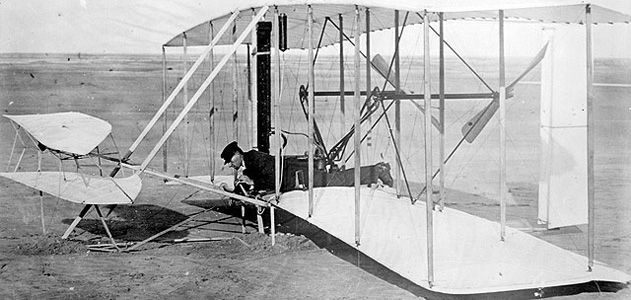
December 17, 2022 — 119 years ago, Orville and Wilbur Wright accomplished the feat that mankind had dreamed about for millennia; to lift off the surface of the earth and to return safely after being aloft for nearly a full minute during one of the first of their flights on this day in 1903.
What I hadn’t realized is that the headwind during the first flights was 27 MPH resulting in a ground speed of less than 7 MPH and a much shorter flight in terms of distance.
December 17, 1903
Three days later [after their first attempt], they were ready for the second attempt. The 27-mph wind was harder than they would have liked, since their predicted cruising speed was only 30-35 mph. The headwind would slow their groundspeed to a crawl, but they proceeded anyway. With a sheet, they signaled the volunteers from the nearby lifesaving station that they were about to try again. Now it was Orville’s turn.Remembering Wilbur’s experience, he positioned himself and tested the controls. The stick that moved the horizontal elevator controlled climb and descent. The cradle that he swung with his hips warped the wings and swung the vertical tails, which in combination turned the machine. A lever controlled the gas flow and airspeed recorder. The controls were simple and few, but Orville knew it would take all his finesse to handle the new and heavier aircraft.
At 10:35, he released the restraining wire. The flyer moved down the rail as Wilbur steadied the wings. Just as Orville left the ground, John Daniels from the lifesaving station snapped the shutter on a preset camera, capturing the historic image of the airborne aircraft with Wilbur running alongside. Again, the flyer was unruly, pitching up and down as Orville overcompensated with the controls. But he kept it aloft until it hit the sand about 120 feet from the rail. Into the 27-mph wind, the groundspeed had been 6.8 mph, for a total airspeed of 34 mph. The brothers took turns flying three more times that day, getting a feel for the controls and increasing their distance with each flight. Wilbur’s second flight – the fourth and last of the day – was an impressive 852 feet in 59 seconds.
This was the real thing, transcending the powered hops and glides others had achieved. The Wright machine had flown. But it would not fly again; after the last flight it was caught by a gust of wind, rolled over, and damaged beyond easy repair. With their flying season over, the Wrights sent their father a matter-of-fact telegram reporting the modest numbers behind their epochal achievement.

I remember when flying used to be fun. However, with the introduction of the TSA (Thousands Standing Around) looking at Americans and not Terrorists, smaller seats, less leg room, and people going nuts, flying is no longer fun.
I remember a time when people dressed nicely to fly. The airline food was editable. Now they have Impossible fake meat. Flying has become a chore. That’s sad. Merry Christmas and Happy New Year, folks
During my active career, I spent a lot of time riding on commercial aircraft. Fortunately, I finished with that before TSA came into being. Damsel and I did take one last round trip to Alaska after TSA, but it was not too bad. I agree that the food on the last Alaska flights was TERRIBLE.
Merry Christmas, Mele Kalikimaka and Happy New Year to you too.